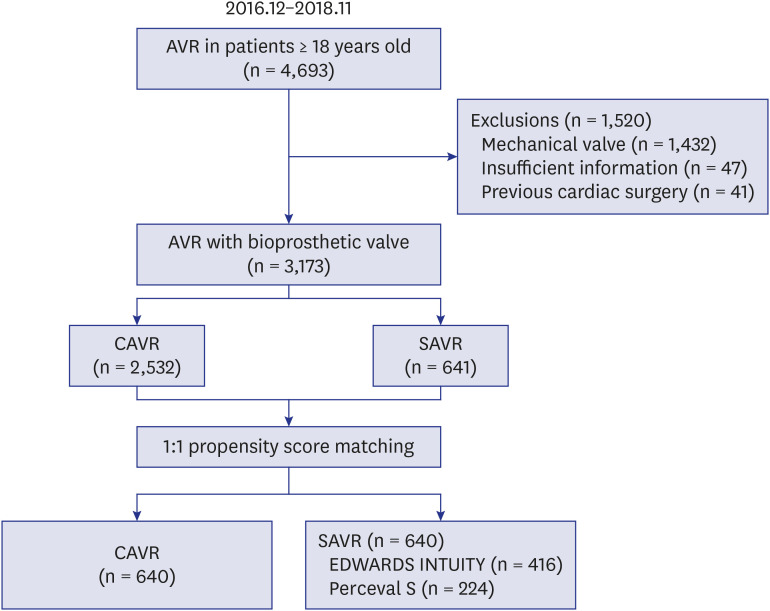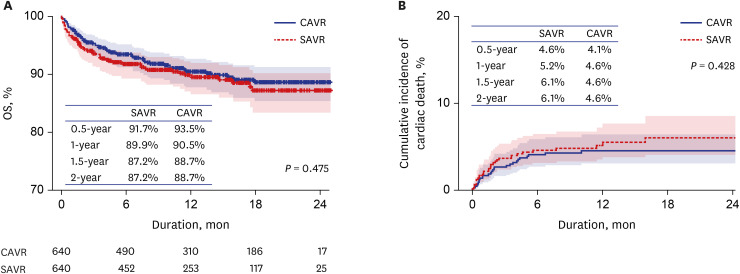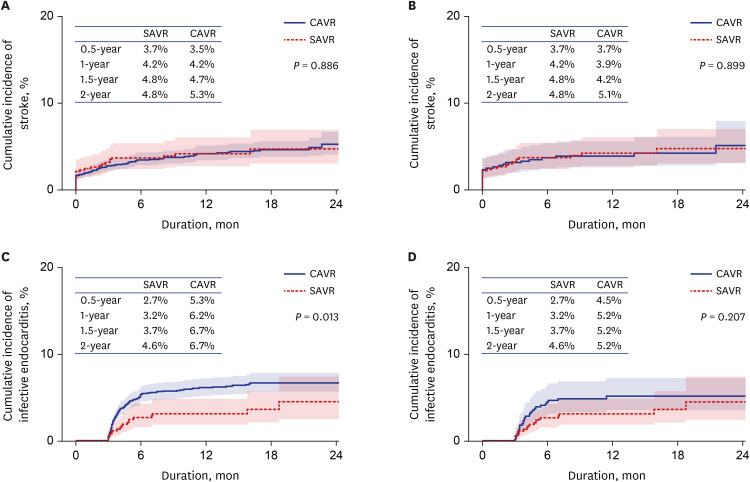J Korean Med Sci.
2021 Mar;36(9):e57. 10.3346/jkms.2021.36.e57.
Early and Two-year Outcomes after Sutureless and Conventional Aortic Valve Replacement: a Nationwide Population-based Study
- Affiliations
-
- 1Department of Thoracic and Cardiovascular Surgery, Seoul National University Hospital, Seoul National University College of Medicine, Seoul, Korea
- 2Department of Thoracic and Cardiovascular Surgery, Asan Medical Center, University of Ulsan College of Medicine, Seoul, Korea
- 3Department of Thoracic and Cardiovascular Surgery, Severance Cardiovascular Hospital, Seoul, Korea
- 4Department of Thoracic and Cardiovascular Surgery, Seoul National University Bundang Hospital, Seoul National University College of Medicine, Seongnam, Korea
- 5Department of Thoracic and Cardiovascular Surgery, CHA Bundang Medical Center, Seongnam, Korea
- 6National Evidence-based Healthcare Collaborating Agency, Seoul, Korea
- KMID: 2513584
- DOI: http://doi.org/10.3346/jkms.2021.36.e57
Abstract
- Background
We compared early and 2-year clinical outcomes of sutureless aortic valve replacement (SAVR) with conventional aortic valve replacement (CAVR) in a nationwide study based on claims data.
Methods
From December 2016 to November 2018, 3,173 patients underwent bioprosthetic aortic valve replacements. SAVR and CAVR were performed in 641 and 2,532 patients, respectively. Propensity score-matched analysis was performed in 640 patient pairs.
Results
Operative mortality rate was 2.8% without significant differences between the SAVR (3.4%) and CAVR (2.3%) groups (P = 0.324). There were no significant differences in postoperative morbidities between the groups except for permanent pacemaker (PPM) implantation. PPM implantation rate was significantly higher in the SAVR (3.8%) than in the CAVR group (0.9%) (P < 0.001). One- and two-year overall survival was 89.1% and 87.5%, respectively, without significant differences between the groups (SAVR group vs. CAVR group = 89.9% and 90.5% vs. 87.2% and 88.7%, respectively; P = 0.475). There were no significant differences in the cumulative incidence of cardiac death, stroke, aortic valve reoperation and infective endocarditis between the groups. Cumulative PPM implantation incidence at 6 months in the CAVR was 1.1%, and no patient required PPM implantation after 6 months. In the SAVR, the cumulative PPM implantation incidence at 0.5, one, and two years was 3.9%, 5.0% and 5.6%, respectively. The cumulative PPM implantation rate was higher in the SAVR group than in the CAVR group (P < 0.001).
Conclusion
Early and 2-year clinical outcomes between SAVR and CAVR were not different except for a high rate of permanent pacemaker implantation in the SAVR group.
Figure
Cited by 1 articles
-
GPTZero Performance in Identifying Artificial Intelligence-Generated Medical Texts: A Preliminary Study
Farrokh Habibzadeh
J Korean Med Sci. 2023;38(38):e319. doi: 10.3346/jkms.2023.38.e319.
Reference
-
1. Leon MB, Smith CR, Mack M, Miller DC, Moses JW, Svensson LG, et al. Transcatheter aortic-valve implantation for aortic stenosis in patients who cannot undergo surgery. N Engl J Med. 2010; 363(17):1597–1607. PMID: 20961243.2. Mack MJ, Leon MB, Thourani VH, Makkar R, Kodali SK, Russo M, et al. Transcatheter aortic-valve replacement with a balloon-expandable valve in low-risk patients. N Engl J Med. 2019; 380(18):1695–1705. PMID: 30883058.
Article3. Popma JJ, Deeb GM, Yakubov SJ, Mumtaz M, Gada H, O'Hair D, et al. Transcatheter aortic-valve replacement with a self-expanding valve in low-risk patients. N Engl J Med. 2019; 380(18):1706–1715. PMID: 30883053.
Article4. Sohn SH, Jang MJ, Hwang HY, Kim KH. Rapid deployment or sutureless versus conventional bioprosthetic aortic valve replacement: a meta-analysis. J Thorac Cardiovasc Surg. 2018; 155(6):2402–2412.e5. PMID: 29548584.
Article5. Wahlers TC, Haverich A, Borger MA, Shrestha M, Kocher AA, Walther T, et al. Early outcomes after isolated aortic valve replacement with rapid deployment aortic valve. J Thorac Cardiovasc Surg. 2016; 151(6):1639–1647. PMID: 26892076.
Article6. Rahmanian PB, Kaya S, Eghbalzadeh K, Menghesha H, Madershahian N, Wahlers T. Rapid deployment aortic valve replacement: excellent results and increased effective orifice area. Ann Thorac Surg. 2018; 105(1):24–30. PMID: 29132703.7. Ranucci M, Frigiola A, Menicanti L, Castelvecchio S, de Vincentiis C, Pistuddi V. Aortic cross-clamp time, new prostheses, and outcome in aortic valve replacement. J Heart Valve Dis. 2012; 21(6):732–739. PMID: 23409353.8. Al-Sarraf N, Thalib L, Hughes A, Houlihan M, Tolan M, Young V, et al. Cross-clamp time is an independent predictor of mortality and morbidity in low- and high-risk cardiac patients. Int J Surg. 2011; 9(1):104–109. PMID: 20965288.
Article9. Iino K, Miyata H, Motomura N, Watanabe G, Tomita S, Takemura H, et al. Prolonged cross-clamping during aortic valve replacement is an independent predictor of postoperative morbidity and mortality: analysis of the Japan cardiovascular surgery database. Ann Thorac Surg. 2017; 103(2):602–609. PMID: 27624296.
Article10. Ensminger S, Fujita B, Bauer T, Möllmann H, Beckmann A, Bekeredjian R, et al. Rapid deployment versus conventional bioprosthetic valve replacement for aortic stenosis. J Am Coll Cardiol. 2018; 71(13):1417–1428. PMID: 29598861.
Article11. Moon TJ. Light and shadows of the Korean healthcare system. J Korean Med Sci. 2012; 27(Suppl):S3–S6. PMID: 22661868.
Article12. Song SO, Jung CH, Song YD, Park CY, Kwon HS, Cha BS, et al. Background and data configuration process of a nationwide population-based study using the korean national health insurance system. Diabetes Metab J. 2014; 38(5):395–403. PMID: 25349827.
Article13. Sundararajan V, Henderson T, Perry C, Muggivan A, Quan H, Ghali WA. New ICD-10 version of the Charlson comorbidity index predicted in-hospital mortality. J Clin Epidemiol. 2004; 57(12):1288–1294. PMID: 15617955.
Article14. Austin PC, Fine JP. Practical recommendations for reporting Fine-Gray model analyses for competing risk data. Stat Med. 2017; 36(27):4391–4400. PMID: 28913837.
Article15. Barnhart GR, Accola KD, Grossi EA, Woo YJ, Mumtaz MA, Sabik JF, et al. TRANSFORM (multicenter experience with rapid deployment EDWARDS INTUITY valve system for aortic valve replacement) US clinical trial: performance of a rapid deployment aortic valve. J Thorac Cardiovasc Surg. 2017; 153(2):241–251.e2. PMID: 27817951.
Article16. Laufer G, Haverich A, Andreas M, Mohr FW, Walther T, Shrestha M, et al. Long-term outcomes of a rapid deployment aortic valve: data up to 5 years. Eur J Cardiothorac Surg. 2017; 52(2):281–287. PMID: 28453629.
Article17. Young C, Laufer G, Kocher A, Solinas M, Alamanni F, Polvani G, et al. One-year outcomes after rapid-deployment aortic valve replacement. J Thorac Cardiovasc Surg. 2018; 155(2):575–585. PMID: 29415382.
Article18. Fischlein T, Meuris B, Hakim-Meibodi K, Misfeld M, Carrel T, Zembala M, et al. The sutureless aortic valve at 1 year: a large multicenter cohort study. J Thorac Cardiovasc Surg. 2016; 151(6):1617–1626.e4. PMID: 26936009.19. Shrestha M, Fischlein T, Meuris B, Flameng W, Carrel T, Madonna F, et al. European multicentre experience with the sutureless Perceval valve: clinical and haemodynamic outcomes up to 5 years in over 700 patients. Eur J Cardiothorac Surg. 2016; 49(1):234–241. PMID: 25750010.
Article20. Di Eusanio M, Phan K, Berretta P, Carrel TP, Andreas M, Santarpino G, et al. Sutureless and Rapid-Deployment Aortic Valve Replacement International Registry (SURD-IR): early results from 3343 patients. Eur J Cardiothorac Surg. 2018; 54(4):768–773. PMID: 29617925.
Article21. Berretta P, Andreas M, Carrel TP, Solinas M, Teoh K, Fischlein T, et al. Minimally invasive aortic valve replacement with sutureless and rapid deployment valves: a report from an international registry (Sutureless and Rapid Deployment International Registry). Eur J Cardiothorac Surg. 2019; 56(4):793–799. PMID: 30820549.
Article22. Gilmanov D, Miceli A, Ferrarini M, Farneti P, Murzi M, Solinas M, et al. Aortic valve replacement through right anterior minithoracotomy: can sutureless technology improve clinical outcomes? Ann Thorac Surg. 2014; 98(5):1585–1592. PMID: 25200732.
Article23. Muneretto C, Alfieri O, Cesana BM, Bisleri G, De Bonis M, Di Bartolomeo R, et al. A comparison of conventional surgery, transcatheter aortic valve replacement, and sutureless valves in “real-world” patients with aortic stenosis and intermediate- to high-risk profile. J Thorac Cardiovasc Surg. 2015; 150(6):1570–1577. PMID: 26384753.
Article24. Meco M, Montisci A, Miceli A, Panisi P, Donatelli F, Cirri S, et al. Sutureless Perceval aortic valve versus conventional stented bioprostheses: Meta-analysis of postoperative and midterm results in isolated aortic valve replacement. J Am Heart Assoc. 2018; 7(4):e006091. PMID: 29453309.
Article25. Andreas M, Wallner S, Habertheuer A, Rath C, Schauperl M, Binder T, et al. Conventional versus rapid-deployment aortic valve replacement: a single-centre comparison between the Edwards Magna valve and its rapid-deployment successor. Interact Cardiovasc Thorac Surg. 2016; 22(6):799–805. PMID: 26976130.
Article26. Kocher AA, Laufer G, Haverich A, Shrestha M, Walther T, Misfeld M, et al. One-year outcomes of the Surgical Treatment of Aortic Stenosis With a Next Generation Surgical Aortic Valve (TRITON) trial: a prospective multicenter study of rapid-deployment aortic valve replacement with the EDWARDS INTUITY Valve System. J Thorac Cardiovasc Surg. 2013; 145(1):110–115. PMID: 23058665.27. Flameng W, Herregods MC, Hermans H, Van der Mieren G, Vercalsteren M, Poortmans G, et al. Effect of sutureless implantation of the Perceval S aortic valve bioprosthesis on intraoperative and early postoperative outcomes. J Thorac Cardiovasc Surg. 2011; 142(6):1453–1457. PMID: 21474151.
Article28. Mehaffey JH, Haywood NS, Hawkins RB, Kern JA, Teman NR, Kron IL, et al. Need for permanent pacemaker after surgical aortic valve replacement reduces long-term survival. Ann Thorac Surg. 2018; 106(2):460–465. PMID: 29577930.
Article29. Greason KL, Lahr BD, Stulak JM, Cha YM, Rea RF, Schaff HV, et al. Long-term mortality effect of early pacemaker implantation after surgical aortic valve replacement. Ann Thorac Surg. 2017; 104(4):1259–1264. PMID: 28433222.
Article30. Concistrè G, Chiaramonti F, Bianchi G, Cerillo A, Murzi M, Margaryan R, et al. Aortic valve replacement with Perceval bioprosthesis: single-center experience with 617 implants. Ann Thorac Surg. 2018; 105(1):40–46. PMID: 28964415.
- Full Text Links
- Actions
-
Cited
- CITED
-
- Close
- Share
- Similar articles
-
- Left Coronary Ostial Obstruction by a Dislocated Sutureless Aortic Valve Prosthesis: Redo Aortic Valve Replacement with Hybrid Coronary Revascularization: A Case Report
- Changes in the Prosthesis Types Used for Aortic Valve Replacement after the Introduction of Sutureless and Rapid Deployment Valves in Korea: A Nationwide Population-Based Cohort Study
- Thrombocytopenia after Aortic Valve Replacement Using Sutureless Valves
- Expanding transcatheter aortic valve replacement into uncharted indications
- Comparable Outcomes of Bicuspid Aortic Valves for RapidDeployment Aortic Valve Replacement






